IT Fundamentals Question Answer 2022
VerifiedAdded on 2022/10/03
|8
|1902
|17
AI Summary
Contribute Materials
Your contribution can guide someone’s learning journey. Share your
documents today.
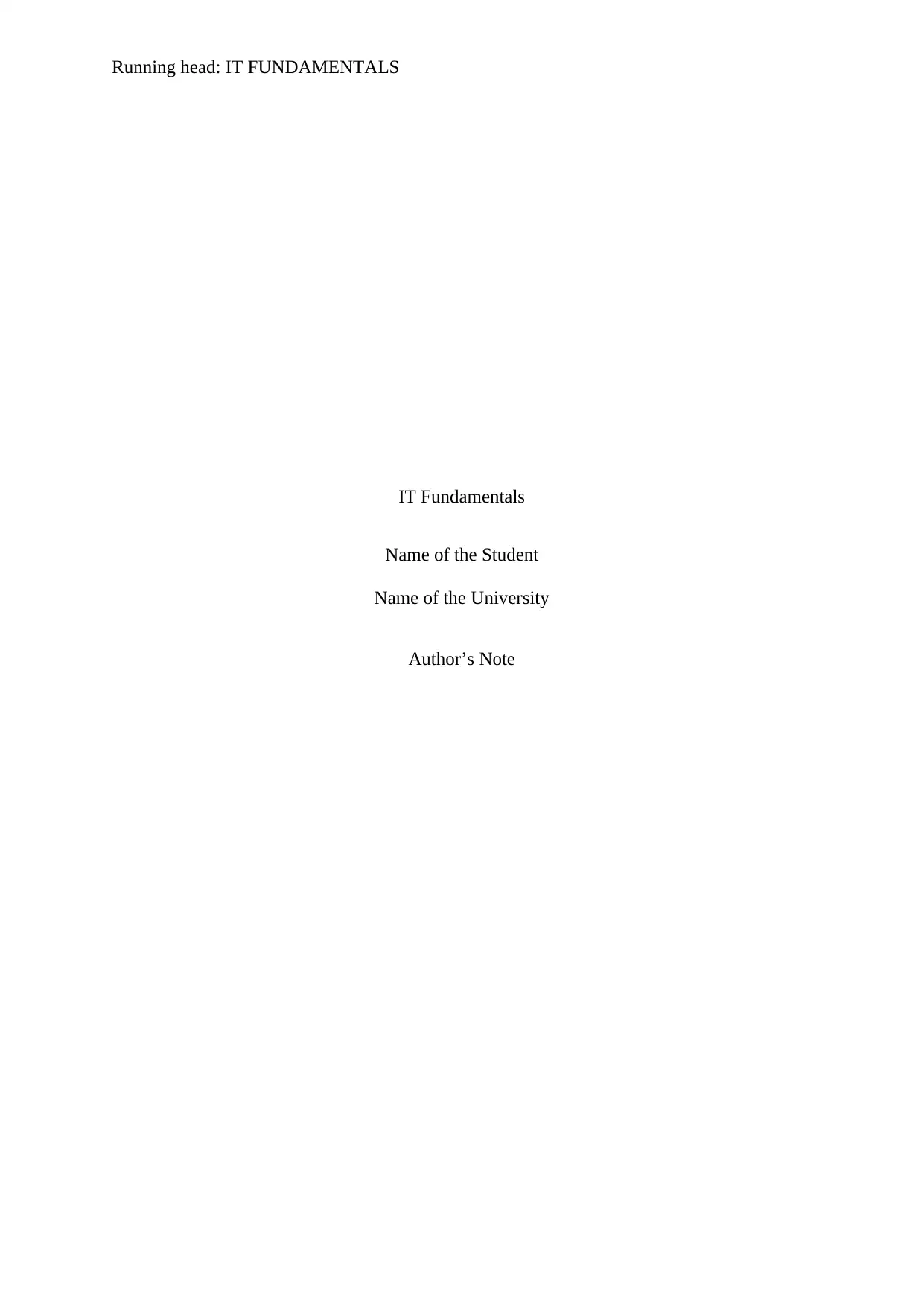
Running head: IT FUNDAMENTALS
IT Fundamentals
Name of the Student
Name of the University
Author’s Note
IT Fundamentals
Name of the Student
Name of the University
Author’s Note
Secure Best Marks with AI Grader
Need help grading? Try our AI Grader for instant feedback on your assignments.
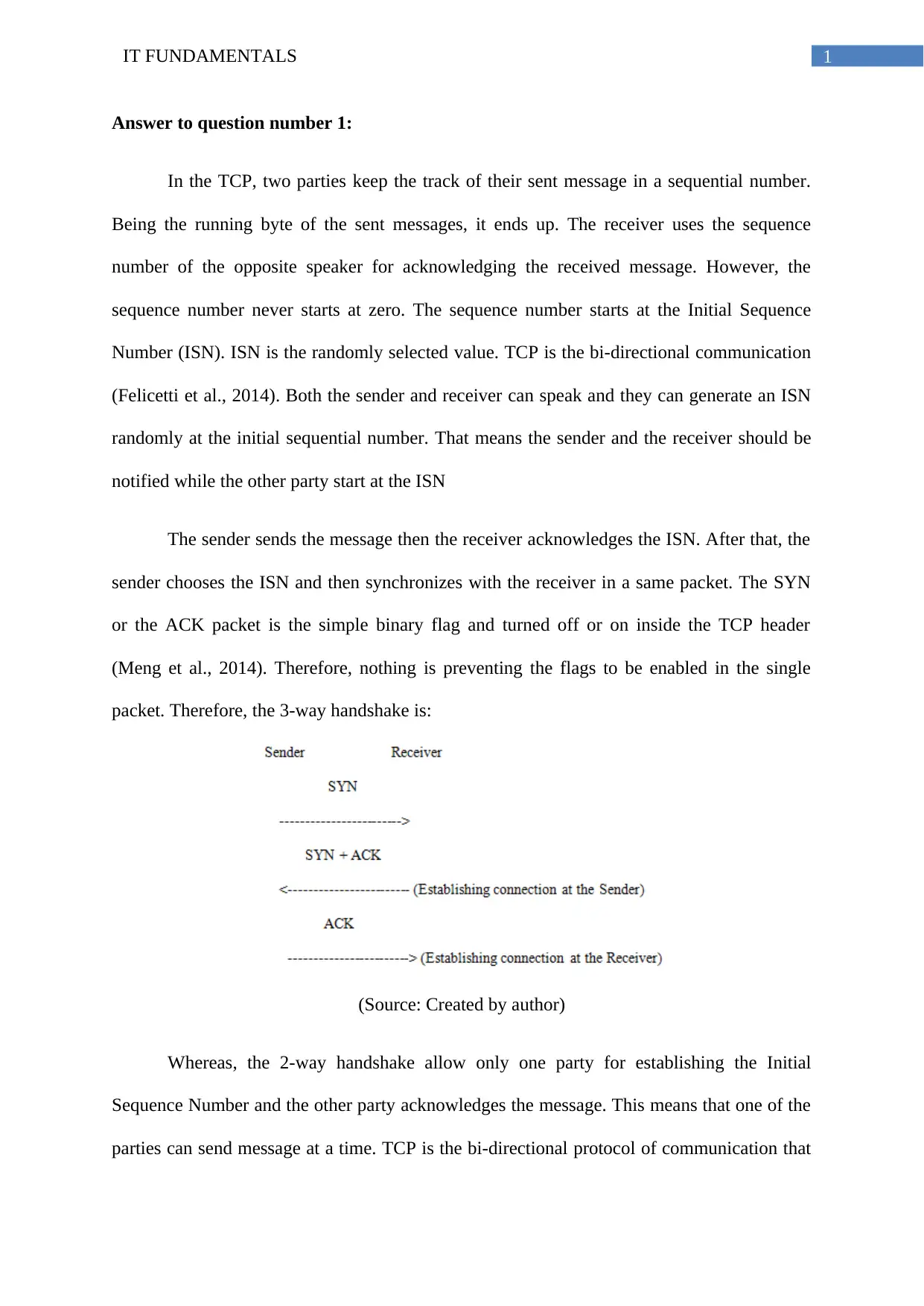
1IT FUNDAMENTALS
Answer to question number 1:
In the TCP, two parties keep the track of their sent message in a sequential number.
Being the running byte of the sent messages, it ends up. The receiver uses the sequence
number of the opposite speaker for acknowledging the received message. However, the
sequence number never starts at zero. The sequence number starts at the Initial Sequence
Number (ISN). ISN is the randomly selected value. TCP is the bi-directional communication
(Felicetti et al., 2014). Both the sender and receiver can speak and they can generate an ISN
randomly at the initial sequential number. That means the sender and the receiver should be
notified while the other party start at the ISN
The sender sends the message then the receiver acknowledges the ISN. After that, the
sender chooses the ISN and then synchronizes with the receiver in a same packet. The SYN
or the ACK packet is the simple binary flag and turned off or on inside the TCP header
(Meng et al., 2014). Therefore, nothing is preventing the flags to be enabled in the single
packet. Therefore, the 3-way handshake is:
(Source: Created by author)
Whereas, the 2-way handshake allow only one party for establishing the Initial
Sequence Number and the other party acknowledges the message. This means that one of the
parties can send message at a time. TCP is the bi-directional protocol of communication that
Answer to question number 1:
In the TCP, two parties keep the track of their sent message in a sequential number.
Being the running byte of the sent messages, it ends up. The receiver uses the sequence
number of the opposite speaker for acknowledging the received message. However, the
sequence number never starts at zero. The sequence number starts at the Initial Sequence
Number (ISN). ISN is the randomly selected value. TCP is the bi-directional communication
(Felicetti et al., 2014). Both the sender and receiver can speak and they can generate an ISN
randomly at the initial sequential number. That means the sender and the receiver should be
notified while the other party start at the ISN
The sender sends the message then the receiver acknowledges the ISN. After that, the
sender chooses the ISN and then synchronizes with the receiver in a same packet. The SYN
or the ACK packet is the simple binary flag and turned off or on inside the TCP header
(Meng et al., 2014). Therefore, nothing is preventing the flags to be enabled in the single
packet. Therefore, the 3-way handshake is:
(Source: Created by author)
Whereas, the 2-way handshake allow only one party for establishing the Initial
Sequence Number and the other party acknowledges the message. This means that one of the
parties can send message at a time. TCP is the bi-directional protocol of communication that
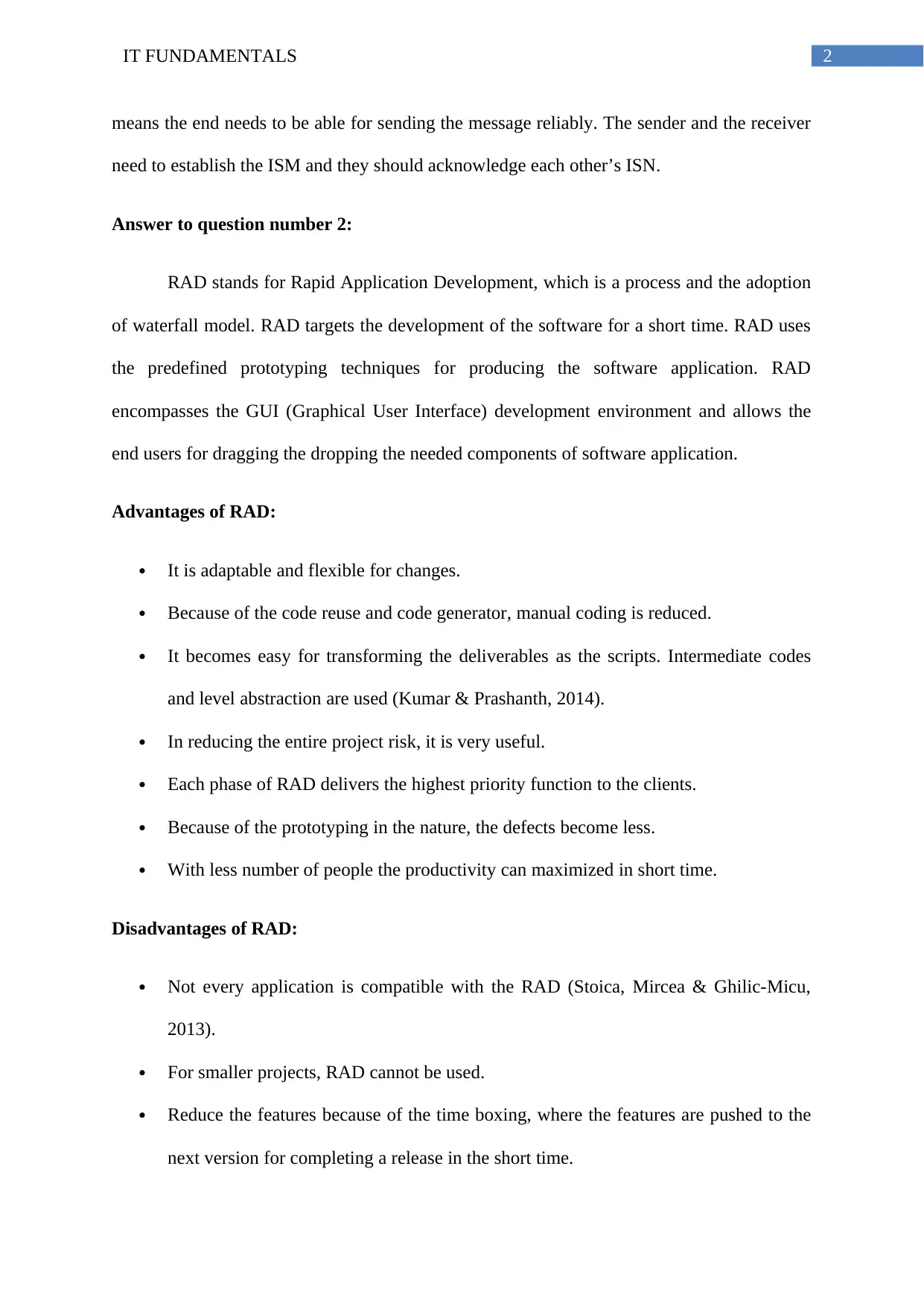
2IT FUNDAMENTALS
means the end needs to be able for sending the message reliably. The sender and the receiver
need to establish the ISM and they should acknowledge each other’s ISN.
Answer to question number 2:
RAD stands for Rapid Application Development, which is a process and the adoption
of waterfall model. RAD targets the development of the software for a short time. RAD uses
the predefined prototyping techniques for producing the software application. RAD
encompasses the GUI (Graphical User Interface) development environment and allows the
end users for dragging the dropping the needed components of software application.
Advantages of RAD:
It is adaptable and flexible for changes.
Because of the code reuse and code generator, manual coding is reduced.
It becomes easy for transforming the deliverables as the scripts. Intermediate codes
and level abstraction are used (Kumar & Prashanth, 2014).
In reducing the entire project risk, it is very useful.
Each phase of RAD delivers the highest priority function to the clients.
Because of the prototyping in the nature, the defects become less.
With less number of people the productivity can maximized in short time.
Disadvantages of RAD:
Not every application is compatible with the RAD (Stoica, Mircea & Ghilic-Micu,
2013).
For smaller projects, RAD cannot be used.
Reduce the features because of the time boxing, where the features are pushed to the
next version for completing a release in the short time.
means the end needs to be able for sending the message reliably. The sender and the receiver
need to establish the ISM and they should acknowledge each other’s ISN.
Answer to question number 2:
RAD stands for Rapid Application Development, which is a process and the adoption
of waterfall model. RAD targets the development of the software for a short time. RAD uses
the predefined prototyping techniques for producing the software application. RAD
encompasses the GUI (Graphical User Interface) development environment and allows the
end users for dragging the dropping the needed components of software application.
Advantages of RAD:
It is adaptable and flexible for changes.
Because of the code reuse and code generator, manual coding is reduced.
It becomes easy for transforming the deliverables as the scripts. Intermediate codes
and level abstraction are used (Kumar & Prashanth, 2014).
In reducing the entire project risk, it is very useful.
Each phase of RAD delivers the highest priority function to the clients.
Because of the prototyping in the nature, the defects become less.
With less number of people the productivity can maximized in short time.
Disadvantages of RAD:
Not every application is compatible with the RAD (Stoica, Mircea & Ghilic-Micu,
2013).
For smaller projects, RAD cannot be used.
Reduce the features because of the time boxing, where the features are pushed to the
next version for completing a release in the short time.
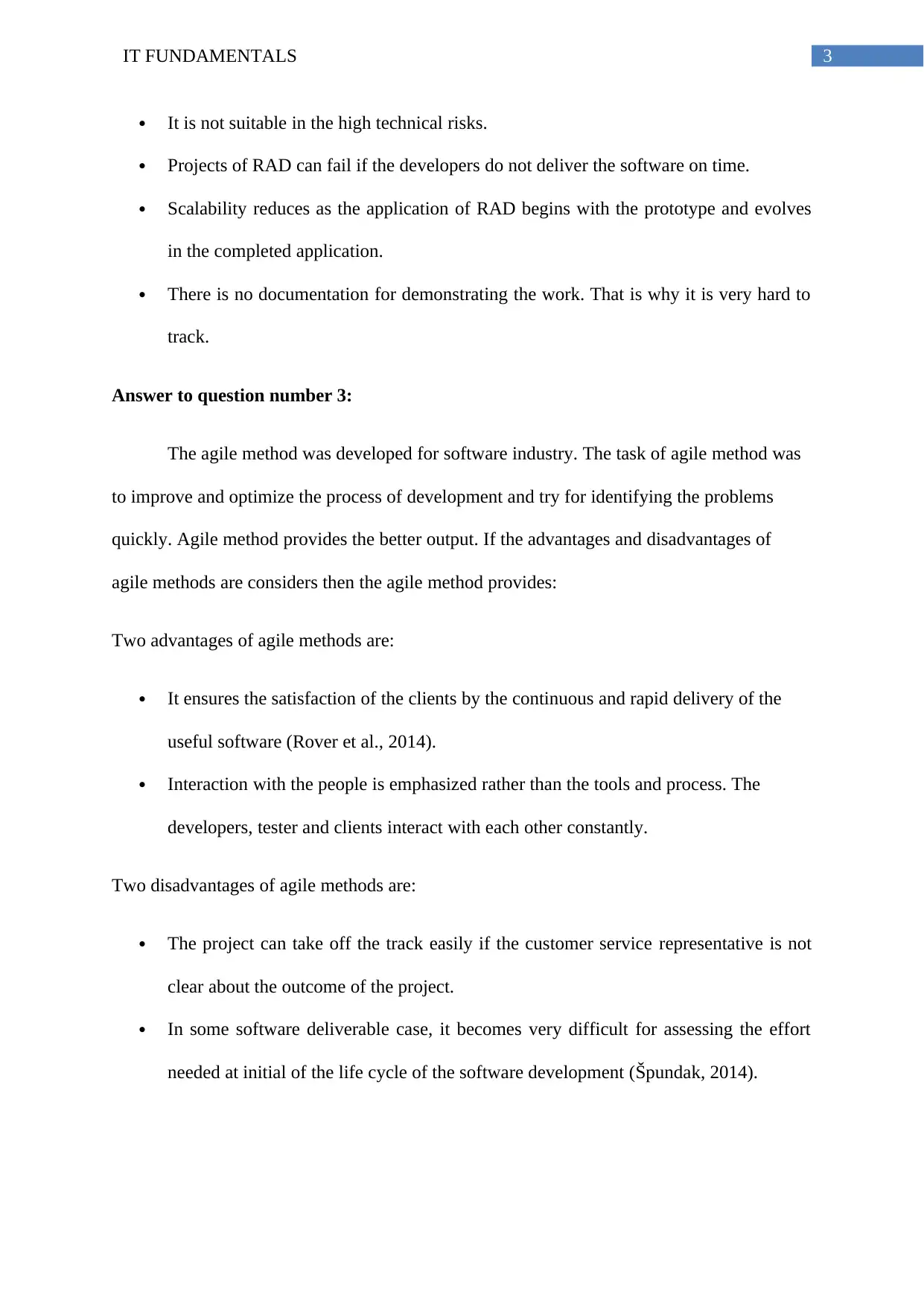
3IT FUNDAMENTALS
It is not suitable in the high technical risks.
Projects of RAD can fail if the developers do not deliver the software on time.
Scalability reduces as the application of RAD begins with the prototype and evolves
in the completed application.
There is no documentation for demonstrating the work. That is why it is very hard to
track.
Answer to question number 3:
The agile method was developed for software industry. The task of agile method was
to improve and optimize the process of development and try for identifying the problems
quickly. Agile method provides the better output. If the advantages and disadvantages of
agile methods are considers then the agile method provides:
Two advantages of agile methods are:
It ensures the satisfaction of the clients by the continuous and rapid delivery of the
useful software (Rover et al., 2014).
Interaction with the people is emphasized rather than the tools and process. The
developers, tester and clients interact with each other constantly.
Two disadvantages of agile methods are:
The project can take off the track easily if the customer service representative is not
clear about the outcome of the project.
In some software deliverable case, it becomes very difficult for assessing the effort
needed at initial of the life cycle of the software development (Špundak, 2014).
It is not suitable in the high technical risks.
Projects of RAD can fail if the developers do not deliver the software on time.
Scalability reduces as the application of RAD begins with the prototype and evolves
in the completed application.
There is no documentation for demonstrating the work. That is why it is very hard to
track.
Answer to question number 3:
The agile method was developed for software industry. The task of agile method was
to improve and optimize the process of development and try for identifying the problems
quickly. Agile method provides the better output. If the advantages and disadvantages of
agile methods are considers then the agile method provides:
Two advantages of agile methods are:
It ensures the satisfaction of the clients by the continuous and rapid delivery of the
useful software (Rover et al., 2014).
Interaction with the people is emphasized rather than the tools and process. The
developers, tester and clients interact with each other constantly.
Two disadvantages of agile methods are:
The project can take off the track easily if the customer service representative is not
clear about the outcome of the project.
In some software deliverable case, it becomes very difficult for assessing the effort
needed at initial of the life cycle of the software development (Špundak, 2014).
Secure Best Marks with AI Grader
Need help grading? Try our AI Grader for instant feedback on your assignments.
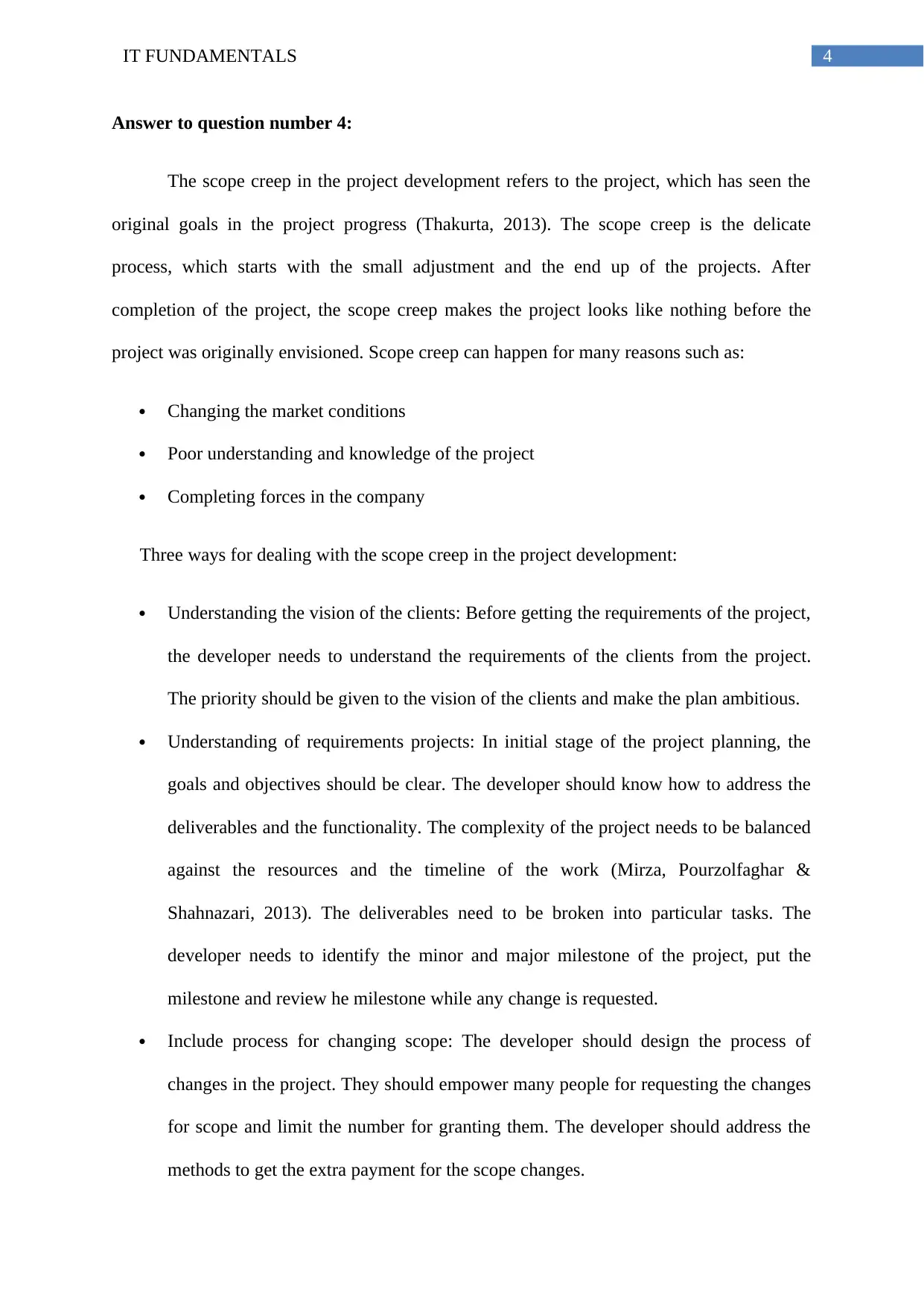
4IT FUNDAMENTALS
Answer to question number 4:
The scope creep in the project development refers to the project, which has seen the
original goals in the project progress (Thakurta, 2013). The scope creep is the delicate
process, which starts with the small adjustment and the end up of the projects. After
completion of the project, the scope creep makes the project looks like nothing before the
project was originally envisioned. Scope creep can happen for many reasons such as:
Changing the market conditions
Poor understanding and knowledge of the project
Completing forces in the company
Three ways for dealing with the scope creep in the project development:
Understanding the vision of the clients: Before getting the requirements of the project,
the developer needs to understand the requirements of the clients from the project.
The priority should be given to the vision of the clients and make the plan ambitious.
Understanding of requirements projects: In initial stage of the project planning, the
goals and objectives should be clear. The developer should know how to address the
deliverables and the functionality. The complexity of the project needs to be balanced
against the resources and the timeline of the work (Mirza, Pourzolfaghar &
Shahnazari, 2013). The deliverables need to be broken into particular tasks. The
developer needs to identify the minor and major milestone of the project, put the
milestone and review he milestone while any change is requested.
Include process for changing scope: The developer should design the process of
changes in the project. They should empower many people for requesting the changes
for scope and limit the number for granting them. The developer should address the
methods to get the extra payment for the scope changes.
Answer to question number 4:
The scope creep in the project development refers to the project, which has seen the
original goals in the project progress (Thakurta, 2013). The scope creep is the delicate
process, which starts with the small adjustment and the end up of the projects. After
completion of the project, the scope creep makes the project looks like nothing before the
project was originally envisioned. Scope creep can happen for many reasons such as:
Changing the market conditions
Poor understanding and knowledge of the project
Completing forces in the company
Three ways for dealing with the scope creep in the project development:
Understanding the vision of the clients: Before getting the requirements of the project,
the developer needs to understand the requirements of the clients from the project.
The priority should be given to the vision of the clients and make the plan ambitious.
Understanding of requirements projects: In initial stage of the project planning, the
goals and objectives should be clear. The developer should know how to address the
deliverables and the functionality. The complexity of the project needs to be balanced
against the resources and the timeline of the work (Mirza, Pourzolfaghar &
Shahnazari, 2013). The deliverables need to be broken into particular tasks. The
developer needs to identify the minor and major milestone of the project, put the
milestone and review he milestone while any change is requested.
Include process for changing scope: The developer should design the process of
changes in the project. They should empower many people for requesting the changes
for scope and limit the number for granting them. The developer should address the
methods to get the extra payment for the scope changes.
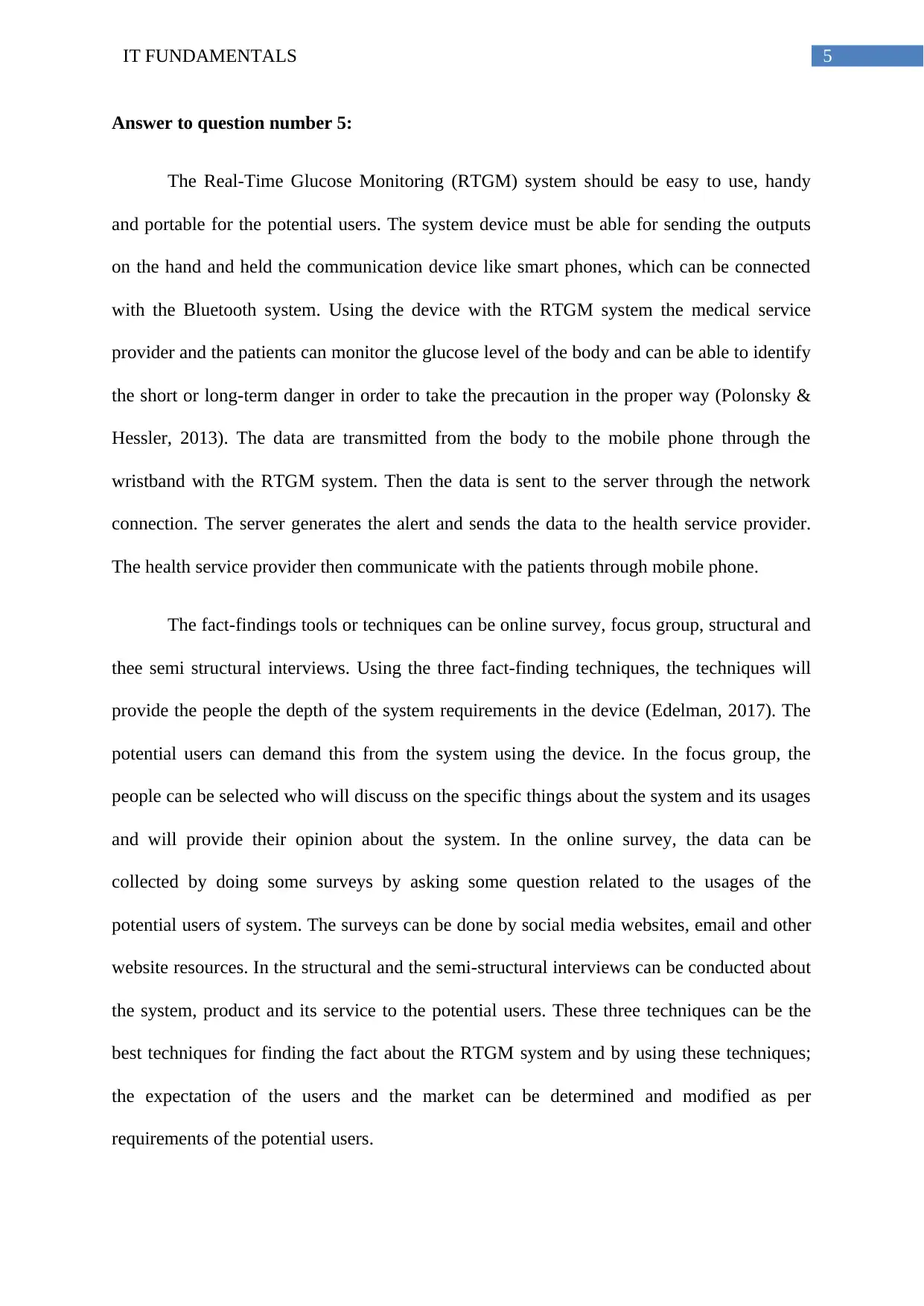
5IT FUNDAMENTALS
Answer to question number 5:
The Real-Time Glucose Monitoring (RTGM) system should be easy to use, handy
and portable for the potential users. The system device must be able for sending the outputs
on the hand and held the communication device like smart phones, which can be connected
with the Bluetooth system. Using the device with the RTGM system the medical service
provider and the patients can monitor the glucose level of the body and can be able to identify
the short or long-term danger in order to take the precaution in the proper way (Polonsky &
Hessler, 2013). The data are transmitted from the body to the mobile phone through the
wristband with the RTGM system. Then the data is sent to the server through the network
connection. The server generates the alert and sends the data to the health service provider.
The health service provider then communicate with the patients through mobile phone.
The fact-findings tools or techniques can be online survey, focus group, structural and
thee semi structural interviews. Using the three fact-finding techniques, the techniques will
provide the people the depth of the system requirements in the device (Edelman, 2017). The
potential users can demand this from the system using the device. In the focus group, the
people can be selected who will discuss on the specific things about the system and its usages
and will provide their opinion about the system. In the online survey, the data can be
collected by doing some surveys by asking some question related to the usages of the
potential users of system. The surveys can be done by social media websites, email and other
website resources. In the structural and the semi-structural interviews can be conducted about
the system, product and its service to the potential users. These three techniques can be the
best techniques for finding the fact about the RTGM system and by using these techniques;
the expectation of the users and the market can be determined and modified as per
requirements of the potential users.
Answer to question number 5:
The Real-Time Glucose Monitoring (RTGM) system should be easy to use, handy
and portable for the potential users. The system device must be able for sending the outputs
on the hand and held the communication device like smart phones, which can be connected
with the Bluetooth system. Using the device with the RTGM system the medical service
provider and the patients can monitor the glucose level of the body and can be able to identify
the short or long-term danger in order to take the precaution in the proper way (Polonsky &
Hessler, 2013). The data are transmitted from the body to the mobile phone through the
wristband with the RTGM system. Then the data is sent to the server through the network
connection. The server generates the alert and sends the data to the health service provider.
The health service provider then communicate with the patients through mobile phone.
The fact-findings tools or techniques can be online survey, focus group, structural and
thee semi structural interviews. Using the three fact-finding techniques, the techniques will
provide the people the depth of the system requirements in the device (Edelman, 2017). The
potential users can demand this from the system using the device. In the focus group, the
people can be selected who will discuss on the specific things about the system and its usages
and will provide their opinion about the system. In the online survey, the data can be
collected by doing some surveys by asking some question related to the usages of the
potential users of system. The surveys can be done by social media websites, email and other
website resources. In the structural and the semi-structural interviews can be conducted about
the system, product and its service to the potential users. These three techniques can be the
best techniques for finding the fact about the RTGM system and by using these techniques;
the expectation of the users and the market can be determined and modified as per
requirements of the potential users.
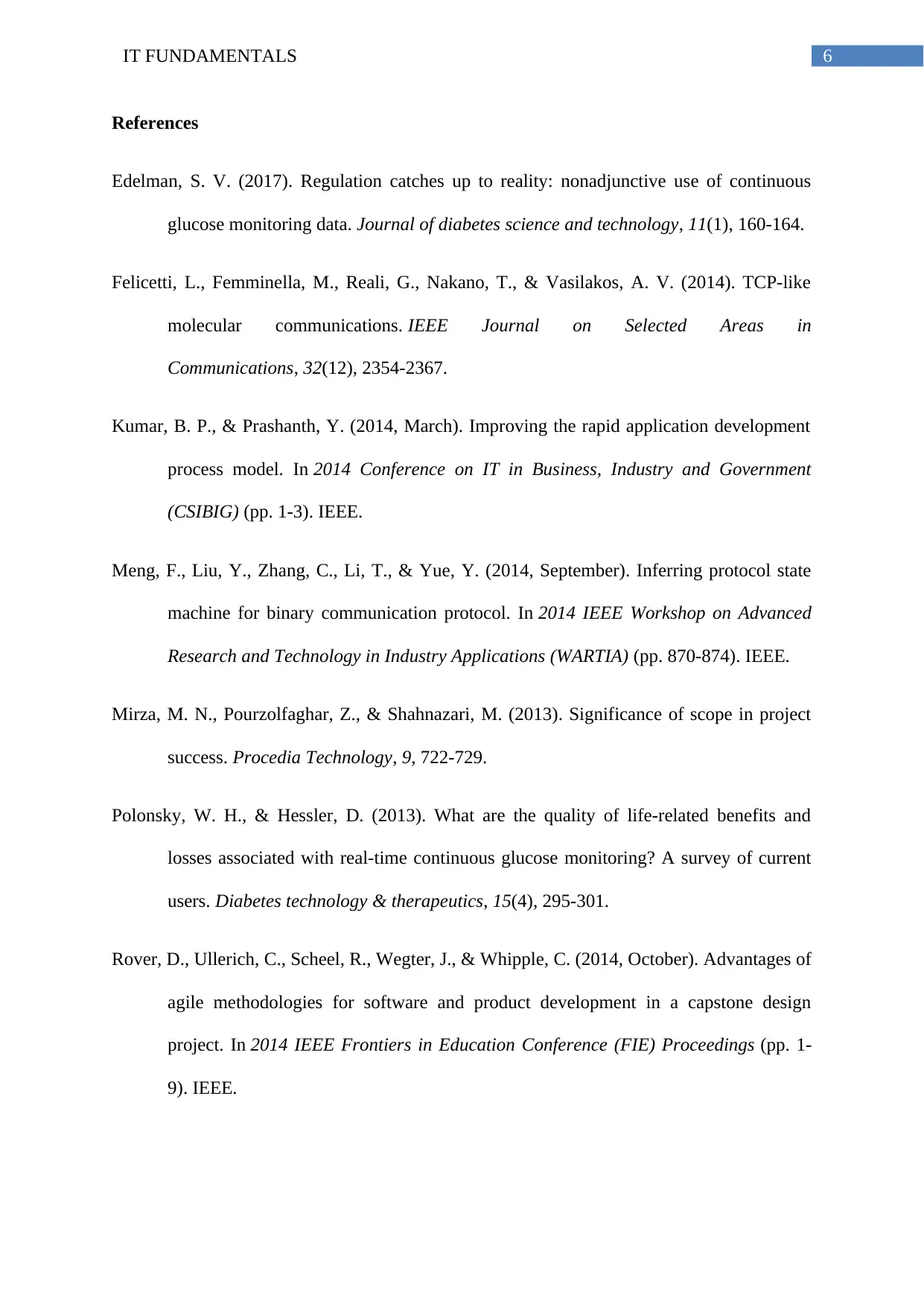
6IT FUNDAMENTALS
References
Edelman, S. V. (2017). Regulation catches up to reality: nonadjunctive use of continuous
glucose monitoring data. Journal of diabetes science and technology, 11(1), 160-164.
Felicetti, L., Femminella, M., Reali, G., Nakano, T., & Vasilakos, A. V. (2014). TCP-like
molecular communications. IEEE Journal on Selected Areas in
Communications, 32(12), 2354-2367.
Kumar, B. P., & Prashanth, Y. (2014, March). Improving the rapid application development
process model. In 2014 Conference on IT in Business, Industry and Government
(CSIBIG) (pp. 1-3). IEEE.
Meng, F., Liu, Y., Zhang, C., Li, T., & Yue, Y. (2014, September). Inferring protocol state
machine for binary communication protocol. In 2014 IEEE Workshop on Advanced
Research and Technology in Industry Applications (WARTIA) (pp. 870-874). IEEE.
Mirza, M. N., Pourzolfaghar, Z., & Shahnazari, M. (2013). Significance of scope in project
success. Procedia Technology, 9, 722-729.
Polonsky, W. H., & Hessler, D. (2013). What are the quality of life-related benefits and
losses associated with real-time continuous glucose monitoring? A survey of current
users. Diabetes technology & therapeutics, 15(4), 295-301.
Rover, D., Ullerich, C., Scheel, R., Wegter, J., & Whipple, C. (2014, October). Advantages of
agile methodologies for software and product development in a capstone design
project. In 2014 IEEE Frontiers in Education Conference (FIE) Proceedings (pp. 1-
9). IEEE.
References
Edelman, S. V. (2017). Regulation catches up to reality: nonadjunctive use of continuous
glucose monitoring data. Journal of diabetes science and technology, 11(1), 160-164.
Felicetti, L., Femminella, M., Reali, G., Nakano, T., & Vasilakos, A. V. (2014). TCP-like
molecular communications. IEEE Journal on Selected Areas in
Communications, 32(12), 2354-2367.
Kumar, B. P., & Prashanth, Y. (2014, March). Improving the rapid application development
process model. In 2014 Conference on IT in Business, Industry and Government
(CSIBIG) (pp. 1-3). IEEE.
Meng, F., Liu, Y., Zhang, C., Li, T., & Yue, Y. (2014, September). Inferring protocol state
machine for binary communication protocol. In 2014 IEEE Workshop on Advanced
Research and Technology in Industry Applications (WARTIA) (pp. 870-874). IEEE.
Mirza, M. N., Pourzolfaghar, Z., & Shahnazari, M. (2013). Significance of scope in project
success. Procedia Technology, 9, 722-729.
Polonsky, W. H., & Hessler, D. (2013). What are the quality of life-related benefits and
losses associated with real-time continuous glucose monitoring? A survey of current
users. Diabetes technology & therapeutics, 15(4), 295-301.
Rover, D., Ullerich, C., Scheel, R., Wegter, J., & Whipple, C. (2014, October). Advantages of
agile methodologies for software and product development in a capstone design
project. In 2014 IEEE Frontiers in Education Conference (FIE) Proceedings (pp. 1-
9). IEEE.
Paraphrase This Document
Need a fresh take? Get an instant paraphrase of this document with our AI Paraphraser
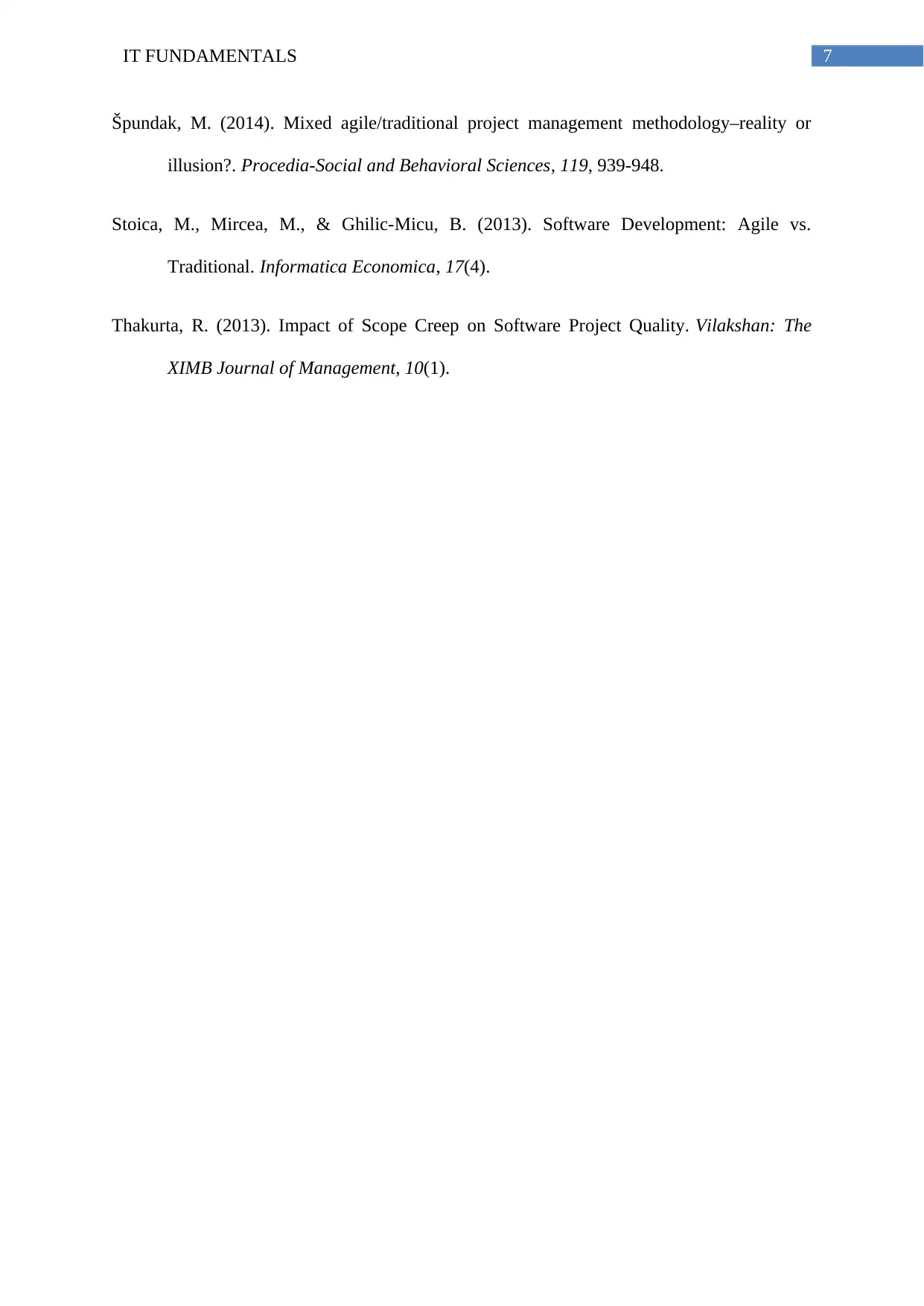
7IT FUNDAMENTALS
Špundak, M. (2014). Mixed agile/traditional project management methodology–reality or
illusion?. Procedia-Social and Behavioral Sciences, 119, 939-948.
Stoica, M., Mircea, M., & Ghilic-Micu, B. (2013). Software Development: Agile vs.
Traditional. Informatica Economica, 17(4).
Thakurta, R. (2013). Impact of Scope Creep on Software Project Quality. Vilakshan: The
XIMB Journal of Management, 10(1).
Špundak, M. (2014). Mixed agile/traditional project management methodology–reality or
illusion?. Procedia-Social and Behavioral Sciences, 119, 939-948.
Stoica, M., Mircea, M., & Ghilic-Micu, B. (2013). Software Development: Agile vs.
Traditional. Informatica Economica, 17(4).
Thakurta, R. (2013). Impact of Scope Creep on Software Project Quality. Vilakshan: The
XIMB Journal of Management, 10(1).
1 out of 8
Related Documents
Your All-in-One AI-Powered Toolkit for Academic Success.
+13062052269
info@desklib.com
Available 24*7 on WhatsApp / Email
![[object Object]](/_next/static/media/star-bottom.7253800d.svg)
Unlock your academic potential
© 2024 | Zucol Services PVT LTD | All rights reserved.





